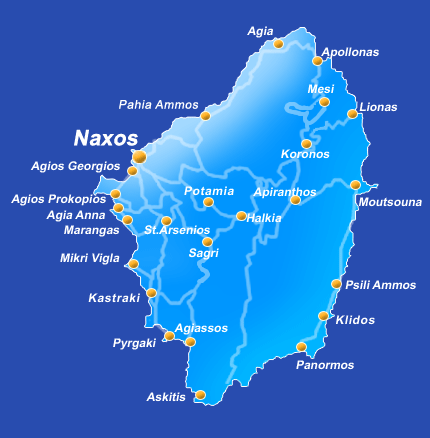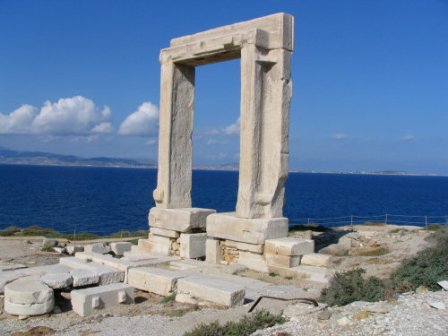

 Click the photo of the Portara above to see an album of photos for Naxos. Close the window to return to this page. |
Read Previous Episode Athens or Next Episode Santorini
| 24 September 2005
- 1 October 2005 We took the Blue Star Ferry from Athens to Naxos, the largest island in the Cyclades at 448 Sq Km, early the first Saturday morning. We were happy to be met by Vagelis Kavuras at the port in Naxos Town (also known as Hora) after our pleasant 5-hour trip. He drove us to his family run Hotel Agios Prokopis, about 6 Km from Hora and just a short walk to the lovely sandy beach, Agios Prokopis. We had spacious studio rooms set around an inviting pool. The hotel served a nice breakfast on the patio every morning and we had either lunch or dinner at one of the restaurants in Hora or Agios Prokopis. Each unit had a basic kitchen that we used to prepare a picnic style meal, which we ate on the patio around the pool. Our host family was especially welcoming, providing us with a bottle of their own quite good wine on two occasions. This is a spot we would return to. The weather was warm and sunny for our week on Naxos so we made sure we swam every day. The beach had the usual profusion of beach chairs and umbrellas to rent but we preferred to pick a spot to put our towels or rush mats on the coarse white sand beach. We were not quite brave enough to join in the nudist section of the beach, but given more time, who knows. The water was pristine and clear and about 75 C in late September. The salt content of the Mediterranean is much higher than the Atlantic or Pacific so floating is a piece of cake. After our swim, we would walk down the almost 2 Km of beach to dry off. In fact, we had almost 10 Km of beach to choose from. Since we had rental cars we were able to try out other nearby beaches. We drove around a small headland and past several restaurants and small hotels to try out Plaka Beach, with finer sand and fewer swimmers. Our tans improved nicely over the week. Naxos had lots of other towns to explore. The Portara (Great Door), all that is left of a 6th C BC temple to Apollo, overlooks Naxos harbour. Naxos Town, has an old section, the Kastro, with narrow winding streets lined with shops and restaurants snaking up a hill to a Venetian castle on the top. Sunday evening we attended an open-air concert and wine tasting in a courtyard next to the Venetian Museum, a typical home built during the Venetian domination in the 13th C AD. We sampled local wines and the unique-to-Naxos Kitron liqueur, a Cointreau variety made from the leaves of a warty looking citrus fruit. That left us in a good mood to enjoy traditional music played on a violin, a bouzouki and a Greek bagpipe. Four young people, members of a traditional dance group in a nearby village, energetically performed for us. The evening ended by Carolyn and I joining a conga line of Greek dancers. The wine helped our expertise. Each day we chose a different route to explore the island of Naxos. Ray and I were keen to hike up to the top of Mount Zas (or Zeus - the Greeks are not fussy about how place names are spelled, variations of place names abound), at 1000 M the highest peak in the Cyclades. Jack and Jenni had a geo-cache to find in a cave on the hill, so we all took off in our rental cars. The narrow, winding road to a parking lot at the start of the walk was the first of many such roads we discovered in the islands. For those people who don't like heights, it is better to close your eyes while negotiating the hill. The rest of us, not the drivers, just enjoyed the great views of the spectacular but barren, rocky landscape. From the parking lot it was a 20-minute walk to a spring just outside a cave that once served as a chapel. Ray helped Jack locate his plastic baggie geo-cache inside the cave and Jack left a pin from his hometown of Quispamsis, outside Saint John NB. Ray and I continued up the mountain on a poorly marked trail. We followed another threesome thinking, erroneously they knew where they were going. As Ray would say, we explored a new route up some loose skree until we finally discovered the easier cairn marked trail to the top. An hour later we were enjoying the view and snapping photos. The trip down was much easier and we rejoined Jack and Jenni back at the car. Lorie and Carolyn had left earlier to explore other nearby towns. After a brief detour to locate yet another geo-cache in a roadside Chapel. Jenni couldn't resist pulling a bell rope to ring the bell in the steeple. I was worried that would bring villagers running to see if there was a fire or other catastrophe, but all was quiet. We hustled back to the car and drove to Apiranthos for lunch. This mountain village, with many of its buildings, streets and walls built of white Naxos marble, is considered the prettiest village on Naxos. It also has several good restaurants, one of which we chose with a balcony overlooking the valley. On the way back to our hotel we stopped in Chalki to visit a Kitron distillery. We had a short tour, sampled the three varieties of this liqueur, and bought a bottle to enjoy after our meals. Our map indicated what looked like a good back-roads route to the Temple of Demeter. Part of it was unpaved, but how bad could it be? It was an adventure. We drove on progressively rougher roads that ended in a farmyard. A helpful farm worker pointed out the road to follow to get to the temple. Ray and I were in the larger Hyundai Accent and drove slowly over the rocky road to reach the paved highway again. When the other four, driving in the smaller Kia Picanto, reached the paved highway, Carolyn got out and kissed the pavement. They were sure they were hitting bottom the whole way and would rip the gas tank open. Luckily it didn't. The Temple of Demeter, Goddess of the Crops, was worth the trip. The site was one of the best presentations we saw. The surroundings had been carefully landscaped with native plants and informative signs were everywhere. Just a few years ago the 6th C BC temple was discovered dismantled on its original site and overbuilt with a 6th C AD chapel, but luckily all the original pieces were there. Archaeologists have been working hard to reconstruct the original temple, built entirely of marble. Even the roof and trusses were marble, giving the whole building a translucent effect in the sunlight. A small museum onsite gave us more information about the work that has been going on. On the way back to our hotel we made a brief visit to another good reconstruction effort. The Temple of Dionysis, started in the 6th C BC as a tribute to the God of Wine. The work is not as advanced as the Temple of Demeter but the informative signs explaining how four different temples expanded the original structure and the olive groves and grapevines surrounding the site made for a peaceful stop. Our road trip to the north end of the island nearly did Lorie in. Jenni had suggested we take a side road to see the Ipsilotera Tower, a Venetian Fortress Monastery of note. Once again the road was unpaved the route got progressively worse. We reached the Tower without incident, but it was not open to visitors and looked rather forbidding. Instead of retracing our route to the main road, we decided to follow the road ahead that on the map came out in a town farther down the main road. Ray and I were alone in the Hyundai and barely made it over what progressed into a cow path, but the other four in the Kia were scraping bottom. When we finally made it into town, Lorie blasted us for taking us on such a dangerous route. Their guidebook apparently said not to go that way. Unfortunately no one informed Ray and I of the caution. We promised not to pick any more yellow (unpaved) roads. Anyway, we made it through without damaging the cars and continued north, stopping now and then to enjoy the view. Jack said he had not expected the island to be as rugged as it is. The western shore where we stayed with its long beaches is relatively flat but the Northeast coast of Naxos is dramatic with the road following along the top of a sheer cliff. Our destination that day was Apollonia, a small fishing village currently being developed as a resort. In late September it was very quiet and picturesque, with outdoor cafes lining the small port. We had coffee and a snack and visited a shop where we all purchased well-made silver jewellery in traditional Greek designs and small reproductions of Cycladic sculptures from 3000 BC in white Naxos marble. Just outside the town is an ancient marble quarry where an unfinished 10 M tall Kouros, a striding man, lay abandoned. The archaeologists say it was probably a figure of Dionysis, the patron God of the island and was rejected in the 6th C BC when part of the statue broke. On our way home we visited another spot where a rejected Kouros, almost as tall as the Apollonia one, lies for eternity. We walked to the Kouros with an elderly Swedish couple. The gentleman told me he had visited Naxos 77 years before but everything had changed. I wonder what it would have seemed like then. We stopped by the road to watch a marble quarry still in operation. While big slabs of marble were cut from the side of a mountain, a bulldozer was pushing unwanted pieces over the side of the hill. What seemed to us huge chunks came tumbling down the mountainside, almost to the road. It would be easy to get small pieces of marble to make sculptures like the ones we bought in Apollonia, but not when the workers were there. Naxos has an excess of small chapels, many from Byzantine times. In some areas it seemed that each family had built their own chapel. It must be a lot of work for the people to maintain them as well as they do. We visited one of the most famous. The Panayia Drossiani, Our Lady of Refreshment, is noted for its frescoes from the 7th and 10th C AD. Just after the frescoes were completed, a severe drought on the island was ended. An Icon of the Virgin Mary was credited with this miracle and hence the name of the church. The frescoes were lovely but I was disappointed that no photos were allowed inside the church. Another afternoon Ray, Jack and I took a short hike up a hillside to visit another Byzantine chapel, Kaloritsa. At least the trail was well marked and we had no trouble finding the chapel. Our guidebook said to visit in the late afternoon so that sunlight would illuminate 13th C AD frescoes painted on the walls of a cave chapel inside the ruins of the main chapel. You cannot go inside the cave but we did have a good view. |
Return to Greece Intro
Return to Travels
Return to Introduction